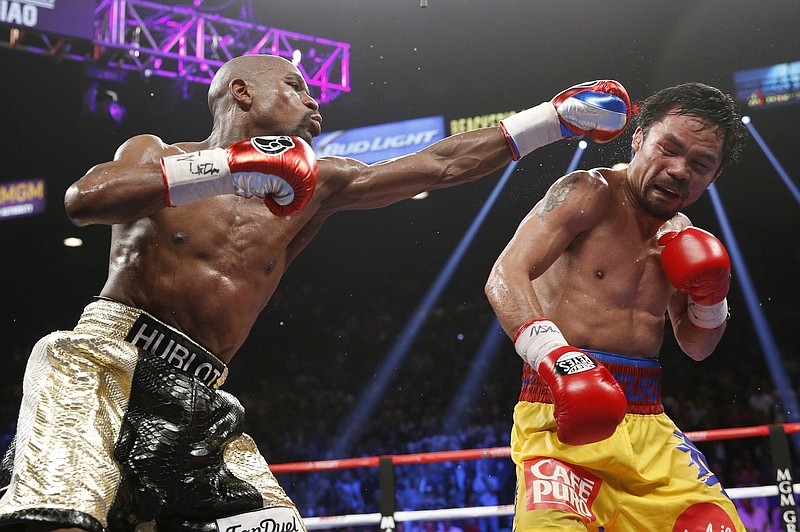All the buzz surrounding last weekend's Manny Pacquiao-Floyd Mayweather fight brings to mind an interesting fact: In the middle years of the 20th century, boxing was a popular obsession in Chattanooga.
Would it surprise you to know that 6,000 people packed the Memorial Auditorium in 1947 to watch a Golden Gloves boxing tournament? Or that most of the public high schools in Hamilton County had boxing teams long before wrestling became entrenched as the more popular sport?
James Hall, 87, certainly remembers.
He and his younger brothers, Fred and Gene, were part of a legendary amateur boxing family here. All three were Southern Golden Gloves champions back in an era when teenage boxers were some of the most exalted athletes in Chattanooga.
Hall, a retired bank executive, lives in a stylish brick home in East Brainerd where he keeps an upstairs office filled with memorabilia from those boxing glory days -- trophies and black-and-white photographs, including one from a championship bout that shows him bleeding from a head-butt.
Hall and some of his octogenarian pals gathered last weekend to watch the big fight on pay-per-view. They represent perhaps the last generation of middle-class Americans to feel personally invested in boxing in the way, say, today's suburban kids will someday feel about recreational soccer or baseball.
Asked about the nine-figure purses in last week's fight, Hall said, "It's unbelievable. That just shows you what [pay-per-view] television can do." [Home viewers paid about $100 per household to watch the 12-round fight won by Mayweather in a unanimous decision.]
In the middle of the 20th century, heavyweight champions of the world -- such as Joe Louis, Rocky Marciano and Muhammad Ali -- were among the most well-known people on the planet, and boxing held an almost mythic station in popular culture. Champions were bigger-than-life heroes; compared to today's fighters, such as Floyd "Money" Mayweather, who are often known more for the size of their bank accounts than the depth of their character.
Hall and his brothers grew up in a meager house in East Ridge, and were fighting one another in their back yard long before they stepped into a boxing ring. All were small in stature -- too little, really, for football -- but possessed of a fighting spirit.
"We were poor," Hall recalls. "My daddy was a postman. We didn't have a car until I was 18 years old. I took $100 from my paper route and bought a 1929 Model A Ford. I painted the wheels yellow. The seat covers were made of chicken feed sacks."
Jim, the oldest, was an accomplished weightlifter before he ever got involved with boxing. In the 1940s, weightlifting was a highly competitive club sport that attracted participants who liked building muscular physiques. Hall is a former Mr. Chattanooga bodybuilder. Old photographs show him with bulging muscles on his 5-foot-6-inch frame.
There was a debate raging at the time as to whether weight training added to or subtracted from athletic prowess, and so Hall's weightlifting coach, Rye Bell, a teacher at Brainerd High School, urged him to try Golden Gloves -- in part to prove that strength training could transfer to the boxing ring.
Hall proved his point resoundingly by winning the Golden Gloves Southern Bantamweight Championship in his first seven fights, which earned him the tag "the Cinderella champion." His younger brothers Gene and Fred would follow in his footsteps, winning the same weight-class championship for themselves a few years later. At one point, Gene won 32 fights in a row before suffering his first defeat in a national Golden Gloves tournament.
Boxing's broad popularity was due, in part, to its weight-class system that allows smaller men to excel against similarly-sized opponents. Most other sports favor tall, brawny athletes who can overpower smaller competitors.
An independent community center called the Frye Institute in downtown Chattanooga served as the incubator for many of the mid-century boxers who went on to earn regional and national acclaim. Fights were regularly held at the Frye Institute's gym as well as at Engel Stadium, the then-home of the Chattanooga Lookouts, and Memorial Auditorium.
The Frye Institute emerged from a bequest by a former real estate man named William Frye, who died in 1910 and left money in his estate to build a facility to help working people. In later years, the Frye Institute on Cherry Street would host everything from weight-lifting clubs to cake decorating classes.
Hall used the tenacity he learned in the ring to build a career in banking. He retired as a senior vice president of First Tennessee Bank. Other prominent Chattanoogans, such as entrepreneurs Thomas "Tommy" Lupton Jr. and R.B. "Rody" Davenport III, were also reported to have donned gloves at Frye Institute as young men.
But those are faded memories now from a long-ago time when boxing was a more persistent presence in mainstream American culture -- not a once-a-decade spectacle involving multi-millionaires.
Contact Mark Kennedy at mkennedy@timesfreepress.com or 423-757-6645. Followhim on Twitter @TFPCOLUMNIST. Subscribe to his Facebook updates at www.facebook.com/mkennedycolumnist.

